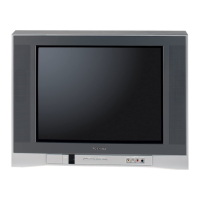
Do you have a question about the Toshiba 20AF46 and is the answer not in the manual?
| Screen Size | 20 inches |
|---|---|
| Display Technology | CRT |
| Aspect Ratio | 4:3 |
| Resolution | 480i |
| Speakers | 2 |
| Inputs | Composite, S-Video, RF |
Follow indications and notices on the cabinet, chassis, and parts.
Caution regarding high voltage parts inside the equipment.
Use parts with specific characters for safety and withstand voltage.
Ensure parts and wires are returned to their original positions after servicing.
Handle the explosion-proof cathode-ray tube with care to avoid damage.
Consider the cathode-ray tube and high voltage circuit for X-ray safety.
Confirm screws, parts, and wiring are in original positions and check insulation.
Details on CRT size, type, color system, and speaker.
Specifications for broadcasting system, tuner, and frequency.
Information on power source, consumption, and protection.
Details on safety, radiation, and certifications.
Operating and storage temperature ranges.
Specifies the acceptable operating humidity range.
Menu types, picture, and sound settings available on screen.
Supported languages for the On-Screen Display.
Sleep timer and on/off timer functions.
Details on unit, format, custom code, power, and keys of the remote.
List of available features like auto degauss, V-Chip, and comb filter.
List of included accessories such as owner's manual and remote control.
Front and rear interface connections for power, terminals, and indicators.
Dimensions of the TV set in millimeters.
Approximate net and gross weight of the television.
Details on master carton and gift box dimensions and origin.
Information on cabinet front, rear, and PCB materials.
Compliance with environmental standards like Pb-free.
Step-by-step guide for safely removing the anode cap from the CRT.
Procedure for removing and installing flat package integrated circuits on PCBs.
Procedure to check the total power-on hours displayed in service mode.
Adjusting the constant voltage to 115 ± 0.5V using a digital voltmeter.
Procedure to adjust screen volume until a dim raster is obtained.
Adjusting R, G, B bias and drive for correct white balance.
Adjusting focus volume for a distinct picture.
Adjusting the horizontal line fit to the shadow mask notch.
Adjusting vertical over scan to 9 ± 2% upside and downside.
Minimizing over scan on upside and downside for vertical linearity.
Adjusting AC voltmeter to 90 ± 2mV at CP101 pin 6.
Minimizing over scan on right and left for horizontal phase.
Adjusting contrast step number to 95 for normal picture.
Adjusting audio output for fine sine wave or minimum R-ch/L-ch output.
Adjusting OSD position to minimize difference between A and B.
Adjusting brightness step number to 80 for visibility.
Adjusting color step number to 66 for correct color balance.
Adjusting tint until section 'A' becomes a straight line.
Checking fixed values for each adjustment item against reference.
Initial adjustment of purity magnets and 4/6 pole magnets.
Adjusting purity magnets and moving deflection yoke for screen purity.
Fine-tuning convergence using 4/6 pole magnets.
Adjusting convergence by moving deflection yoke and fixing with wedges.
Layout diagram of components on the Main/CRT board (inserted parts).
Layout diagram of components on the Main/CRT board (chip mounted parts).
Waveforms related to the Micon circuitry.
Waveforms related to the Chroma signal processing.
Waveforms related to the deflection circuitry.
Waveforms related to the audio output circuits.
Waveforms related to the Comb Filter and AV input signals.
Waveforms related to the CRT signal outputs.
